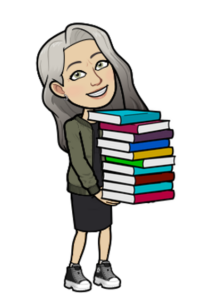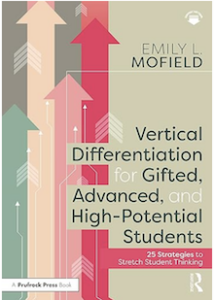Strategies to Adjust ‘Up’ What Students Know
Vertical Differentiation for Gifted, Advanced and High-Potential Students: 25 Strategies to Stretch Student Thinking
By Emily L. Mofield
(Routledge/Prufrock Press, 2023 – Learn more)
Reviewed by Leslie Wise, Ed.D.

“With my daughter, she was bored with math, because they couldn’t keep up, you know; I mean she just mastered it too quickly for the grade.” – Parent of 6th grade student.
“When they are done, he gets to read, which he loves, so he flies through his assignments and makes really stupid mistakes. But see, he’s not motivated to be a perfectionist or to get the right answer. He thinks, Well, if it’s in the 90s, what do you care if it’s 100. It’s still a good grade, and he gets to read quicker.” – Parent of 5th grade student

How does a teacher meet the needs of a class of 5th graders reading from a 1st grade to a 9th grade level?
A compendium of excellent, well-tested methods
Emily L. Mofield has compiled a practical, realistic and highly readable set of 25 different approaches to that question in her Vertical Differentiation for Gifted, Advanced and High-Potential Students: 25 Strategies to Stretch Student Thinking. And almost any classroom teacher would find highly useful.
Mofield – an education professor with a gifted education focus – details both the strategies and the content areas in which strategies might be used, allowing teachers, coaches and administrators to utilize this book as a compendium of excellent, well-tested teaching methods that also provides innovative applications of these strategies.
Vertical differentiation, Mofield explains, allows for “adjusting ‘up’ what students know, understand, and do by providing challenges where students are grappling with cognitively complex tasks that prepare them to create, practice, and think as an expert” (pg. 9). She offers strategies designed “to increase the cognitive expectations” for all students (pg. 3).
In addition to my role as a Library Media Specialist, I serve as a gifted enrichment teacher in a pull-out model. I have the opportunity to focus on the needs of the students in the gifted program several times a week as well as to meet for bi-weekly sessions with every student in the school in my regular Media Literacy classes. Mofield’s 25 strategies can apply to either configuration I teach.
My own copy of this book is unfit to share with others because of the volume of notes I took while I was reading, including phrases such as “useful comparison to SEM [schoolwide enrichment model],” “share with 5th grade team for social studies,” and “students will love.”
A closer look at the book
Mofield organizes the 25 strategies within broader categories to assist teachers with ease of implementation, including Analysis, Problem Solving, Creative Thinking, Constructing Arguments, Metacognition, and Deep Learning. Each specific strategy includes a description of its use, including its history and related research, as well as an example.
Mofield’s strength lies in her ability to organize, contextualize and expand the application of what she refers to as “tried and true” methods in the field of education. For example, when Mofield discusses de Bono’s 6 Thinking Hats approach (Strategy #9) within the Understanding the Problem chapter, she starts by explaining the basic model: “Yellow Hat – identifies benefits and positive attributes” (p. 81).
She then suggests that this model can go even further to develop complex thinking if the Thinking Hats are combined with Paul and Elder’s Elements of Thought (e.g. Purpose, Question, Assumptions) from Chapter 2, to add an additional layer of perspectives to the issue at hand.
If that combination seems overwhelming, she makes it accessible by adding three pages of a completed handout using these combined strategies, including a link to the digital copy of the chart template (resources available in one pdf; access limited to those who purchase the book by asking a text-specific question as a password). This same model is used throughout the book for each of the 25 strategies: describe, connect to tenets of gifted education, demonstrate its application.
The talent development model
Mofield’s frequent reference to the talent development model increases the breadth of applications for these strategies. For example, she reminds us that Passow’s “Would, Could, Should” Litmus Test for gifted-appropriate content asks, “Would all children want to be involved in such learning experiences? Could all children participate… Should all children be expected to succeed…?” (p. 27).
Mofield suggests that vertical differentiation can support a talent development model of Would/Could/Should, offering the example of a Would question asking: “Would the exposure to high-level content and challenge lead to next steps in talent development?” (p. 28), with similar examples for Could and Should.
Frameworks for thinking
In addition to the strategies, Mofield focuses on The Big Picture (Chapter 2) which focuses on frameworks for thinking. Their strategic placement at the beginning of the book lays the groundwork for the vertical differentiation strategies to follow, but these frameworks are also practical in their own right.
For instance, her combination of Kettler et al.’s Taxonomy of Creativity (p. 39) with Cambridge’s Assessment Taxonomy of Critical Thinking Skills (p. 35) leads to her own Combined Critical and Creative Thinking Matrix (Table 2.3, p. 40). I have printed this chart and placed it in my gifted curriculum binder because of how it allows for the amalgamation of two perspectives on thinking (i.e. creative and critical) into applicable examples, such as “analysis” (critical) + “original work” (creative) = “assess the relevance, plausibility, and credibility of one’s innovate idea” (p. 40).
An approachable and practical resource
Overall, Mofield has provided a highly utilitarian, accessible and practical guide to some of the most effective vertical differentiation strategies available. Her writing style is highly approachable and makes the implementation of these strategies both realistic and reasonable.
I believe the addition of this title to the reading list of a Professional Learning Community (PLC) would be welcomed because, among other things, it passes the “tomorrow” test – is this something I could use in my classroom tomorrow? For me, yes, 25 and more times over.
Resources
Rambo-Hernandez, K.E. et al. (2023). How Academically-Diverse is the “Grade-Level” Classroom? Open Science Framework. https://osf.io/89fvn/
The goal of increasing student access to opportunities motivated Leslie Wise, Ed.D., to write her dissertation on gifted education and experiential, student-driven pedagogies, which she also writes about at GiftedWeekly.com. Having taught at the intermediate and middle school levels for over 15 years, Leslie’s primary role as a Media Specialist in Middlesex, New Jersey, allows her to utilize the district’s innovative STEAM-focused library curriculum to challenge students to think critically and creatively.






























